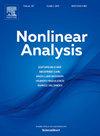Regularity for infinitely degenerate inhomogenous elliptic equations, Part I: The Moser Method
IF 1.3
2区 数学
Q1 MATHEMATICS
引用次数: 0
Abstract
We show that if is equipped with a certain non-doubling metric and an Orlicz-Sobolev inequality holds for a special family of Young functions , then weak solutions to quasilinear infinitely degenerate elliptic equations of the form are locally bounded. This is obtained by the implementation of a Moser iteration method, what constitutes the first instance of such technique applied to infinite degenerate equations. The results presented here partially extend previously known estimates for solutions of similar equations in which the right hand side does not have a drift term. We also obtain bounds for small negative powers of nonnegative solutions, which will be applied in a subsequent paper to prove continuity of solutions. We also provide examples of geometries in which our abstract theorem is applicable. We consider the family of functions infinitely degenerate at the origin, and show that all weak solutions to with rough data , are locally bounded when and .
无穷退化非齐次椭圆方程的正则性,第1部分:Moser方法
我们证明了如果Rn具有一定的非加倍度规,并且对于一类特殊的Young函数Φ, Orlicz-Sobolev不等式成立,则形式为- divAx,u∇u=ϕ0 - divAϕ→1的拟线性无限退化椭圆方程的弱解是局部有界的。这是通过实现莫泽迭代法得到的,它构成了这种技术应用于无限退化方程的第一个实例。本文给出的结果部分地扩展了以前已知的类似方程解的估计,其中右手边没有漂移项。我们还得到了非负解的小负幂的界,将在后续的文章中用于证明解的连续性。我们还提供了可以应用抽象定理的几何例子。我们考虑函数族fk,σx=xlnk1xσ,k∈N,σ>0,−∞<x<∞,在原点处无限简并,并证明了所有的弱解- divAx,y,u∇u= x,y - divAϕ→1x,y,Ax,y,z ~ 100fk,σx2,粗糙数据A, 0, φ→1,在k=1和0<;σ<;1时是局部有界的。
本文章由计算机程序翻译,如有差异,请以英文原文为准。
求助全文
约1分钟内获得全文
求助全文
来源期刊
CiteScore
3.30
自引率
0.00%
发文量
265
审稿时长
60 days
期刊介绍:
Nonlinear Analysis focuses on papers that address significant problems in Nonlinear Analysis that have a sustainable and important impact on the development of new directions in the theory as well as potential applications. Review articles on important topics in Nonlinear Analysis are welcome as well. In particular, only papers within the areas of specialization of the Editorial Board Members will be considered. Authors are encouraged to check the areas of expertise of the Editorial Board in order to decide whether or not their papers are appropriate for this journal. The journal aims to apply very high standards in accepting papers for publication.

 求助内容:
求助内容: 应助结果提醒方式:
应助结果提醒方式:


